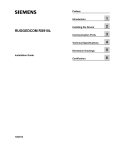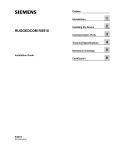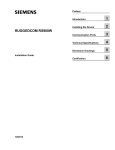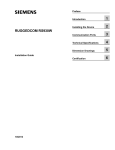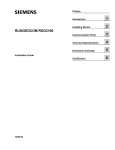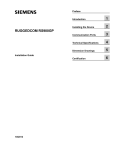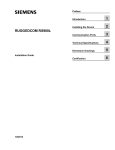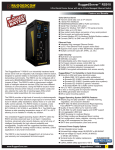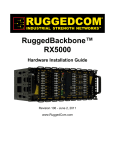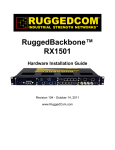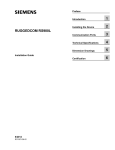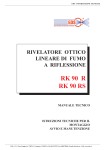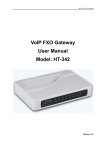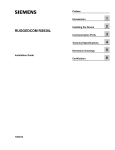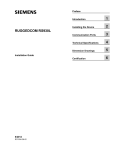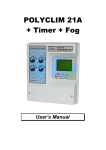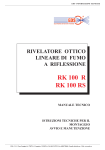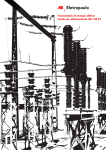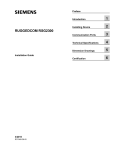Download RUGGEDCOM RS910
Transcript
Preface RUGGEDCOM RS910 Introduction 1 Installing the Device 2 Communication Ports 3 Technical Specifications 4 Dimension Drawings 5 Certification 6 Installation Guide 10/2013 RUGGEDCOM RS910 Installation Guide Copyright © 2013 Siemens AG All rights reserved. Dissemination or reproduction of this document, or evaluation and communication of its contents, is not authorized except where expressly permitted. Violations are liable for damages. All rights reserved, particularly for the purposes of patent application or trademark registration. This document contains proprietary information, which is protected by copyright. All rights are reserved. No part of this document may be photocopied, reproduced or translated to another language without the prior written consent of Siemens AG. Disclaimer Of Liability Siemens has verified the contents of this manual against the hardware and/or software described. However, deviations between the product and the documentation may exist. Siemens shall not be liable for any errors or omissions contained herein or for consequential damages in connection with the furnishing, performance, or use of this material. The information given in this document is reviewed regularly and any necessary corrections will be included in subsequent editions. We appreciate any suggested improvements. We reserve the right to make technical improvements without notice. Registered Trademarks ROX™, Rugged Operating System On Linux™, CrossBow™ and eLAN™ are trademarks of Siemens AG. ROS® is a registered trademark of Siemens AG. Other designations in this manual might be trademarks whose use by third parties for their own purposes would infringe the rights of the owner. Third Party Copyrights Siemens recognizes the following third party copyrights: • Copyright © 2004 GoAhead Software, Inc. All Rights Reserved. Security Information Siemens provides products and solutions with industrial security functions that support the secure operation of plants, machines, equipment and/or networks. They are important components in a holistic industrial security concept. With this in mind, Siemens ’ products and solutions undergo continuous development. Siemens recommends strongly that you regularly check for product updates. For the secure operation of Siemens products and solutions, it is necessary to take suitable preventive action (e.g. cell protection concept) and integrate each component into a holistic, state-of-the-art industrial security concept. Third-party products that may be in use should also be considered. For more information about industrial security, visit http://www.siemens.com/industrialsecurity. To stay informed about product updates as they occur, sign up for a product-specific newsletter. For more information, visit http:// support.automation.siemens.com. Warranty Siemens warrants this product for a period of five (5) years from the date of purchase, conditional upon the return to factory for maintenance during the warranty term. This product contains no user-serviceable parts. Attempted service by unauthorized personnel shall render all warranties null and void. The warranties set forth in this article are exclusive and are in lieu of all other warranties, performance guarantees and conditions whether written or oral, statutory, express or implied (including all warranties and conditions of merchantability and fitness for a particular purpose, and all warranties and conditions arising from course of dealing or usage or trade). Correction of nonconformities in the manner and for the period of time provided above shall constitute the Seller’s sole liability and the Customer’s exclusive remedy for defective or nonconforming goods or services whether claims of the Customer are based in contract (including fundamental breach), in tort (including negligence and strict liability) or otherwise. For warranty details, visit www.siemens.com/ruggedcom or contact a Siemens customer service representative. Contacting Siemens ii Address Telephone E-mail Siemens AG Industry Sector 300 Applewood Crescent Concord, Ontario Canada, L4K 5C7 Toll-free: 1 888 264 0006 Tel: +1 905 856 5288 Fax: +1 905 856 1995 [email protected] Web www.siemens.com/ruggedcom RUGGEDCOM RS910 Installation Guide Table of Contents Table of Contents Preface ................................................................................................................ v Alerts .................................................................................................................................................. v Related Documents ............................................................................................................................. v Accessing Documentation .................................................................................................................... v Training .............................................................................................................................................. vi Customer Support .............................................................................................................................. vi Chapter 1 Introduction .......................................................................................................... 1 1.1 Feature Highlights ........................................................................................................................ 1 1.2 Ports, Controls and Indicator LEDs ............................................................................................... 2 Chapter 2 Installing the Device ............................................................................................ 5 2.1 Mounting the Device .................................................................................................................... 5 2.1.1 Mounting the Device on a DIN Rail .................................................................................... 6 2.1.2 Mounting the Device to a Panel ......................................................................................... 6 2.2 Connecting Power ........................................................................................................................ 7 2.2.1 Connecting High AC/DC Power .......................................................................................... 8 2.2.2 Connecting Low DC Power ................................................................................................ 9 2.3 Connecting the Failsafe Alarm Relay ........................................................................................... 10 2.4 Connecting to the Device ........................................................................................................... 11 2.5 Cabling Recommendations ......................................................................................................... 12 Chapter 3 Communication Ports ......................................................................................... 13 3.1 Copper Ethernet Ports ................................................................................................................ 14 3.2 Fiber Optic Ethernet Ports .......................................................................................................... 14 3.3 Serial Ports ................................................................................................................................ 15 3.4 Connecting Multiple RS485 Devices ............................................................................................ 17 Chapter 4 Technical Specifications ..................................................................................... 19 4.1 Power Supply Specifications ....................................................................................................... 19 4.2 Failsafe Relay Specifications ...................................................................................................... 19 4.3 Copper Ethernet Port Specifications ............................................................................................ 20 iii Table of Contents RUGGEDCOM RS910 Installation Guide 4.4 10Base-FL Fiber Optic Ethernet Port Specifications ...................................................................... 20 4.5 Fiber Optic Ethernet Port Specifications ....................................................................................... 20 4.6 Serial Port Specifications ............................................................................................................ 21 4.6.1 Copper Serial Port Specifications ..................................................................................... 22 4.6.2 Fiber Serial Port Specifications ......................................................................................... 22 4.7 Operating Environment ............................................................................................................... 22 4.8 Mechanical Specifications ........................................................................................................... 22 Chapter 5 Dimension Drawings .......................................................................................... 25 Chapter 6 Certification ........................................................................................................ 27 6.1 Agency Approvals ...................................................................................................................... 27 6.2 FCC Compliance ........................................................................................................................ 27 6.3 Industry Canada Compliance ...................................................................................................... 27 6.4 EMI and Environmental Type Tests ............................................................................................. 28 iv RUGGEDCOM RS910 Installation Guide Preface Preface This guide describes the RUGGEDCOM RS910. It describes the major features of the device, installation, commissioning and important technical specifications. It is intended for use by network technical support personnel who are responsible for the installation, commissioning and maintenance of the device. It is also recommended for use by network and system planners, system programmers, and line technicians. Alerts The following types of alerts are used when necessary to highlight important information. DANGER! DANGER alerts describe imminently hazardous situations that, if not avoided, will result in death or serious injury. WARNING! WARNING alerts describe hazardous situations that, if not avoided, may result in serious injury and/or equipment damage. CAUTION! CAUTION alerts describe hazardous situations that, if not avoided, may result in equipment damage. IMPORTANT! IMPORTANT alerts provide important information that should be known before performing a procedure or step, or using a feature. NOTE NOTE alerts provide additional information, such as facts, tips and details. Related Documents Other documents that may be of interest include: • ROS User Guide for RS910LW/RS920LW Accessing Documentation The latest Hardware Installation Guides and Software User Guides for most RUGGEDCOM products are available online at www.siemens.com/ruggedcom. Alerts v Preface RUGGEDCOM RS910 Installation Guide For any questions about the documentation or for assistance finding a specific document, contact a Siemens sales representative. Training Siemens offers a wide range of educational services ranging from in-house training of standard courses on networking, Ethernet switches and routers, to on-site customized courses tailored to the customer's needs, experience and application. Siemens' Educational Services team thrives on providing our customers with the essential practical skills to make sure users have the right knowledge and expertise to understand the various technologies associated with critical communications network infrastructure technologies. Siemens' unique mix of IT/Telecommunications expertise combined with domain knowledge in the utility, transportation and industrial markets, allows Siemens to provide training specific to the customer's application. For more information about training services and course availability, visit www.siemens.com/ruggedcom or contact a Siemens sales representative. Customer Support Customer support is available 24 hours, 7 days a week for all Siemens customers. For technical support or general information, please contact Customer Support at: Toll Free (North America): 1 866 922 7975 International: +1 905 856 5288 Website: http://support.automation.siemens.com vi Training RUGGEDCOM RS910 Installation Guide Chapter 1 Introduction Introduction The RUGGEDCOM RS910 is an industrially hardened serial device server with an integrated, fully managed, Ethernet switch, designed to operate reliably in electrically harsh and climatically demanding environments. The RS910 can be configured with two serial ports (RS485/RS422/RS232) and/or up to three Ethernet ports (copper or fiber). The RS910 is able to interconnect multiple types of intelligent electronic devices (IEDs) that have different methods of communications. Using the RS910 results in fewer connectivity devices (which reduces overall system costs) and also extends the useful life of existing legacy IEDs (which minimizes capital expenditure for new equipment). The RS910 provides a high level of immunity to electromagnetic interference and heavy electrical surges typical of environments found in electric utility substations, factory floors or in curb side traffic control cabinets. The RS910 meets or exceeds a wide range of industry standards including IEC 61850, IEEE 1613, IEC 61000-6-2, IEC 61800-3, and NEMA TS-2. The RS910 also features a wide operating temperature range of -40 to 85 °C (-40 to 185 °F) allowing it to be installed in virtually any location. The following sections provide more information about the RS910: • Section 1.1, “Feature Highlights” • Section 1.2, “Ports, Controls and Indicator LEDs” Section 1.1 Feature Highlights Serial Device Server • Baud rates up to 230 kbps • Transmit serial data over an IP network • RS485/RS422/RS232 Serial Ports (DB9 or RJ45 connectors) • Serial Fiber Interface (ST) option • Direct support for Modbus TCP, DNP 3, TIN serial protocols • Raw socket mode allows conversion of any serial protocol • Point-to-Point (P2P) and multi-point modes • Converts Modbus RTU to Modbus • Multiple Modbus masters • Converts DNP3.0 to DNP over UDP/TCP Ethernet Ports • Integrated fully managed Ethernet Switch • Up to three Fast Ethernet Ports (copper and/or fiber) • Supports many types of fiber (Multimode, Singlemode) • Industry standard fiber optical connectors: LC, SC, ST, MTRJ Feature Highlights 1 Chapter 1 Introduction RUGGEDCOM RS910 Installation Guide Cyber Security • Multi-level user passwords • SSH/SSL (128-bit encryption) • Enable/disable ports, MAC based port security • Port based network access control (802.1x) • VLAN (802.1Q) to segregate and secure network traffic • RADIUS centralized password management • SNMPv3 authentication and 56-bit encryption Rated for Reliability in Harsh Environments • Immunity to EMI and heavy electrical surges ▪ Meets IEEE 1613 class 1 (electric utility substations) ▪ Exceeds IEC 61850-3 (electric utility substations) ▪ Exceeds IEC 61800-3 (variable speed drive systems) ▪ Exceeds IEC 61000-6-2 (generic industrial) ▪ Exceeds NEMA TS-2 (traffic control equipment) • Hazardous Location Certification: Class 1 Division 2 • -40 to 85 °C (-40 to 185 °F) operating temperature (no fans) • 20 AWG galvanized steel enclosure • DIN or panel mounting options provide secure mechanical reliability • Conformal coated printed circuit boards (optional) Management Tools • Web-based, Telnet, CLI management interfaces • SNMP v1/v2/v3 (56-bit encryption) • Remote Monitoring (RMON) • Rich set of diagnostics with logging and alarms Universal Power Supply Options • Fully integrated power supply • Universal high-voltage range: 88-300 VDC or 85-264 VAC • Dual low-voltage DC inputs: 24 VDC (10-36 VDC) or 48 VDC (36-72 VDC) • Terminal blocks for reliable maintenance free connections • CSA/UL 60950-1 safety approved to 85 °C (185 °F) Section 1.2 Ports, Controls and Indicator LEDs The RS910 features various ports, controls and indicator LEDs on the front panel for configuring and troubleshooting the device. 2 Ports, Controls and Indicator LEDs RUGGEDCOM RS910 Chapter 1 Installation Guide Introduction 1 2 3 Figure 1: Front Panel 1. Power Indicator LEDs 2. Alarm Indicator LED 3. RS232 Serial Console Port Power Indicator LEDs The power indicator LED illuminates when power is being supplied to the device. Alarm Indicator LED The alarm indicator LED illuminates when an alarm condition exists. RS232 Serial Console Port This port is for interfacing directly with the device and accessing initial management functions. Ports, Controls and Indicator LEDs 3 RUGGEDCOM RS910 Installation Guide Ports, Controls and Indicator LEDs Chapter 1 Introduction 4 RUGGEDCOM RS910 Installation Guide Chapter 2 Installing the Device Installing the Device The following sections describe how to install the device, including mounting the device, installing/removing modules, connecting power, and connecting the device to the network. WARNING! Radiation hazard – risk of serious personal injury. This product contains a laser system and is classified as a CLASS 1 LASER PRODUCT. Use of controls or adjustments or performance of procedures other than those specified herein may result in hazardous radiation exposure. DANGER! Electrocution hazard – risk of serious personal injury and/or damage to equipment. Before performing any maintenance tasks, make sure all power to the device has been disconnected and wait approximately two minutes for any remaining energy to dissipate. IMPORTANT! This product contains no user-serviceable parts. Attempted service by unauthorized personnel shall render all warranties null and void. Changes or modifications not expressly approved by Siemens AG could invalidate specifications, test results, and agency approvals, and void the user's authority to operate the equipment. IMPORTANT! This product should be installed in a restricted access location where access can only be gained by authorized personnel who have been informed of the restrictions and any precautions that must be taken. Access must only be possible through the use of a tool, lock and key, or other means of security, and controlled by the authority responsible for the location. • Section 2.1, “Mounting the Device” • Section 2.2, “Connecting Power” • Section 2.3, “Connecting the Failsafe Alarm Relay” • Section 2.4, “Connecting to the Device” • Section 2.5, “Cabling Recommendations” Section 2.1 Mounting the Device The RS910 is designed for maximum mounting and display flexibility. It can be equipped with connectors that allow it to be installed in a 35 mm (1.4 in) DIN rail or directly on a panel. NOTE For detailed dimensions of the device with either DIN rail or panel hardware installed, refer to Chapter 5, Dimension Drawings. The following sections describe the various methods of mounting the device: Mounting the Device 5 Chapter 2 RUGGEDCOM RS910 Installing the Device Installation Guide • Section 2.1.1, “Mounting the Device on a DIN Rail” • Section 2.1.2, “Mounting the Device to a Panel” Section 2.1.1 Mounting the Device on a DIN Rail For DIN rail installations, the RS910 can be equipped with a DIN rail bracket pre-installed on the back of the chassis. The bracket allows the device to be slid onto a standard 35 mm (1.4 in) DIN rail. To mount the device to a DIN rail, do the following: 1. Align the slot in the bracket with the DIN rail. 1 1 2 Figure 2: DIN Rail Mounting 1. DIN Rail 2. 2. DIN Rail Bracket Pull the release on the bracket down and slide the device onto the DIN rail. Let go of the release to lock the device in position. Section 2.1.2 Mounting the Device to a Panel For panel installations, the RS910 can be equipped with panel adapters pre-installed on the top and bottom of the chassis. The adapters allow the device to be attached to a panel using screws. To mount the device to a panel, do the following: 1. 6 Place the device against the panel and align the adapters with the mounting holes. Mounting the Device on a DIN Rail RUGGEDCOM RS910 Chapter 2 Installation Guide Installing the Device 1 2 2 1 Figure 3: Panel Mounting 1. Screw 2. 2. Panel Adaptor Install the supplied screws to secure the adapters to the panel. Section 2.2 Connecting Power The RS910 supports a single integrated high AC/DC or low DC power supply NOTE • For 110/230 VAC rated equipment, an appropriately rated AC circuit breaker must be installed. • For 125/250 VDC rated equipment, an appropriately rated DC circuit breaker must be installed. • Equipment must be installed according to applicable local wiring codes and standards. • All line-to-ground transient energy is shunted to the Surge Ground terminal. In cases where users require the inputs to be isolated from ground, remove the ground braid between Surge and Chassis Ground. Note that all line-to-ground transient protection circuitry will be disabled. IMPORTANT! Siemens requires the use of external surge protection in VDSL applications where the line may be subject to surges greater than that for which the device is rated. Use the following specifications as a guide for VDSL external surge protection: • Clamping Voltage: 50 V to 200 V Connecting Power 7 Chapter 2 Installing the Device RUGGEDCOM RS910 Installation Guide • Insertion Loss: < 0.1 dB at 10 MHz • Peak Surge Current: 10 kA, 8x20µs waveform The following sections describe how to connect power to the device: • Section 2.2.1, “Connecting High AC/DC Power” • Section 2.2.2, “Connecting Low DC Power” Section 2.2.1 Connecting High AC/DC Power To connect a high AC/DC power supply to the device, do the following: CAUTION! Electrical hazard – risk of damage to equipment. Do not connect AC power cables to terminals for DC power. Damage to the power supply may occur. CAUTION! Electrical hazard – risk of damage to equipment. Before testing the dielectric strength (HIPOT) in the field, remove the braided ground cable connected to the surge ground terminal and chassis ground. This cable connects transient suppression circuitry to chassis ground and must be removed in order to avoid damage to transient suppression circuitry during testing. 1. 8 Connect the positive wire from the power source to the positive/live (+/L) terminal on the terminal block. Connecting High AC/DC Power RUGGEDCOM RS910 Chapter 2 Installation Guide Installing the Device 4 1 2 3 Figure 4: Terminal Block Wiring 1. Positive/Live (+/L) Terminal 2. Negative/Neutral (-/N) Terminal 3. Surge Ground Terminal 4. Braided Ground Cable 2. Connect the negative wire from the power source to the negative/neutral (-/N) terminal on the terminal block. 3. Using a braided wire or other appropriate grounding wire, connect the surge ground terminal to the chassis ground connection. The surge ground terminal is used as the ground conductor for all surge and transient suppression circuitry internal to the unit. 4. Connect the ground terminal on the power source to the chassis ground terminal on the device. Section 2.2.2 Connecting Low DC Power To connect a low DC power supply to the device, do the following: CAUTION! Electrical hazard – risk of damage to equipment. Before testing the dielectric strength (HIPOT) in the field, remove the braided ground cable connected to the surge ground terminal and chassis ground. This cable connects transient suppression circuitry to chassis ground and must be removed in order to avoid damage to transient suppression circuitry during testing. 1. Connect the positive wire from the power source to the positive terminal on the terminal block. Connecting Low DC Power 9 Chapter 2 RUGGEDCOM RS910 Installing the Device Installation Guide 4 1 2 3 Figure 5: Terminal Block Wiring 1. Positive Terminal 2. Negative Terminal 3. Surge Ground Terminal 4. Braided Ground Cable 2. Connect the negative wire from the power source to the negative terminal on the terminal block. 3. Using a braided wire or other appropriate grounding wire, connect the surge ground terminal to the chassis ground connection. The surge ground terminal is used as the ground conductor for all surge and transient suppression circuitry internal to the unit. 4. Connect the ground terminal on the power source to the chassis ground terminal on the device. Section 2.3 Connecting the Failsafe Alarm Relay The failsafe relay can be configured to latch based on alarm conditions. The NO (Normally Open) contact is closed when the unit is powered and there are no active alarms. If the device is not powered or if an active alarm is configured, the relay opens the NO contact and closes the NC (Normally Closed) contact. NOTE Control of the failsafe relay output is configurable through ROS . One common application for this relay is to signal an alarm if a power failure occurs. For more information, refer to the ROS User Guide for the RS910. The following shows the proper relay connections. 10 Connecting the Failsafe Alarm Relay RUGGEDCOM RS910 Chapter 2 Installation Guide Installing the Device 1 2 3 Figure 6: Failsafe Alarm Relay Wiring 1. Normally Open 2. Common 3. Normally Closed Section 2.4 Connecting to the Device The following describes the various methods for accessing the ROS console and Web interfaces on the device. For more detailed instructions, refer to the ROS User Guide for the RS910. Serial Console Port Connect a PC or terminal directly to the serial console port to access the boot-time control and ROS console interface. IMPORTANT! The serial console port is intended to be used only as temporary connections during initial configuration or troubleshooting. The serial console port implements RS232 DCE (Data Communication Equipment) on a DB9 connector. The following is the pin-out for the port: 5 1 9 6 Figure 7: Serial DB9 Console Port Connecting to the Device Pin Name Description 1 DCD Data Carrier Detect 2 RX Receive Data 3 TX Transmit Data 4 DTR Data Terminal Ready 5 GND Signal Ground 6 DSR Data Set Ready 7 RTS Request to Send 8 CTS Clear To Send 9 Reserved (Do Not Connect) 11 Chapter 2 Installing the Device RUGGEDCOM RS910 Installation Guide Communication Ports Connect any of the available Ethernet ports on the device to a management switch and access the ROS console and Web interfaces via the device's IP address. For more information about available ports, refer to Chapter 3, Communication Ports. Section 2.5 Cabling Recommendations Siemens does not recommend the use of copper cabling of any length for critical, real-time substation automation applications. All copper Ethernet ports on RUGGEDCOM products include transient suppression circuitry to protect against damage from electrical transients and conform with IEC 61850-3 and IEEE 1613 Class 1 standards. This means that during a transient electrical event, communications errors or interruptions may occur, but recovery is automatic. Siemens also does not recommend using copper Ethernet ports to interface with devices in the field across distances that could produce high levels of ground potential rise (i.e. greater than 2500 V), during line-to-ground fault conditions. 12 Cabling Recommendations RUGGEDCOM RS910 Chapter 3 Installation Guide Communication Ports Communication Ports The RS910 can be equipped with various types of communication ports to enhance its abilities and performance. To determine which ports are equipped on the device, refer to the factory data file available through ROS . For more information on how to access the factory data file, refer to the ROS User Guide for the RS910. Each communication port type has a specific place in the RS910 chassis. 3 2 1 Figure 8: Port Assignment 1. Ports 1 to 2 2. Ports 3 to 4 3. Port 9 Port Type 1 to 2 Serial Ports 3 to 4 Fast Ethernet Ports (10/100Base-TX or 10/100Base-FX) 9 Fast Ethernet Port (10/100Base-TX or 10/100Base-FX) The following sections describe the available ports: • Section 3.1, “Copper Ethernet Ports” • Section 3.2, “Fiber Optic Ethernet Ports” • Section 3.3, “Serial Ports” • Section 3.4, “Connecting Multiple RS485 Devices” 13 Chapter 3 RUGGEDCOM RS910 Communication Ports Installation Guide Section 3.1 Copper Ethernet Ports The RS910 supports several 10/100Base-TX Ethernet ports that allow connection to standard Category 5 (CAT-5) unshielded twisted-pair (UTP) cables with RJ45 male connectors. The RJ45 receptacles are directly connected to the chassis ground on the device and can accept CAT-5 shielded twisted-pair (STP) cables. WARNING! Electric shock hazard – risk of serious personal injury and/or equipment interference. If shielded cables are used, make sure the shielded cables do not form a ground loop via the shield wire and the RJ45 receptacles at either end. Ground loops can cause excessive noise and interference, but more importantly, create a potential shock hazard that can result in serious injury. Each port features a Speed and Link LED that indicates the state of the port. LED State Description Speed Yellow The port is operating at 100 Mbps Off The port is operating at 10 Mbps Yellow (Solid) Link established Yellow (Blinking) Link activity Off No link detected Link The following is the pin-out for the RJ45 male connectors: 8 1 Figure 9: RJ45 Ethernet Port Pin Configuration Pin Name Description 1 RX+ Receive Data+ 2 RX- Receive Data- 3 TX+ Transmit Data+ 4 Reserved (Do Not Connect) 5 Reserved (Do Not Connect) 6 TX- Transmit Data- 7 Reserved (Do Not Connect) 8 Reserved (Do Not Connect) For specifications on the available copper Ethernet ports, refer to Section 4.3, “Copper Ethernet Port Specifications”. Section 3.2 Fiber Optic Ethernet Ports Fiber optic Ethernet ports are available with either MTRJ (Mechanical Transfer Registered Jack), LC (Lucent Connector), SC (Standard or Subscriber Connector) or ST (Straight Tip) connectors. Make sure the Transmit (Tx) and Receive (Rx) connections of each port are properly connected and matched to establish a proper link. 14 Copper Ethernet Ports RUGGEDCOM RS910 Chapter 3 Installation Guide Communication Ports 1 1 2 Figure 11: LC Port Figure 10: MTRJ Port 1. Tx Connector 2 Figure 12: SC Port 1. Tx Connector 1. Tx Connector 2. Rx Connector 1 2. Rx Connector 2 2. Rx Connector 1 2 Figure 13: ST Port 1. Tx Connector 2. Rx Connector For specifications on the available fiber optic Ethernet ports, refer to Section 4.5, “Fiber Optic Ethernet Port Specifications”. Section 3.3 Serial Ports The RS910 supports DB9, RJ45 and SC (Standard or Subscriber Connector) fiber serial ports, all of which can be run in RS232, RS485 or RS422 mode. NOTE On power-up, all serial ports default to RS485 mode. Each port can be individually set to RS232, RS485 or RS422 mode through ROS . For more information, refer to the ROS User Guide for the RS910. All serial ports feature an LED that indicates the current state of the port. State Description Green Link activity detected Off No link detected For specifications on serial ports, refer to Section 4.6, “Serial Port Specifications”. For information about how to connect devices configured to run in RS485 mode, refer to Section 3.4, “Connecting Multiple RS485 Devices”. The following are the pin-outs for the DB9, RJ45 and SC connectors: Serial Ports 15 Chapter 3 RUGGEDCOM RS910 Communication Ports Installation Guide Pin 5 1 a RS232 Mode 1 DCD 2 TX 3 RX 4 DTR 6 TX+ b DSR RX- cd 7 CTS TX/RX- TX- cd 8 RTS 9 RI (No Connection) Shield Chassis Ground a No internal termination is provided. b The Common terminal is optically isolated. However, there is transient voltage protection circuitry between the Common terminal and chassis ground. c Connected internally. d In RS232 mode, this pin enters a high impedance state. A DTE that asserts RTS will see CTS asserted, although the device will not perform hardware flow control. Pin 8 Figure 15: Serial RJ45 Port 1 e RS232 Mode f DSR/RI 2 f DCD 3 DTR 1 4 RS485 Mode RS422 Mode RX- Common (Isolated) Ground 5 RX 6 TX 7 CTS 8 RTS Shield 16 TX/RX+ Common (Isolated Ground) 6 Figure 14: Serial DB9 Port RS422 Mode RX+ 5 9 RS485 Mode RX+ TX/RX+ TX+ TX/RX- TX- fg g Chassis Ground e No internal termination is provided. f Connected internally. g In RS232 mode, this pin enters a high impedance state. A DTE that asserts RTS will see CTS asserted, although the device will not perform hardware flow control. Serial Ports RUGGEDCOM RS910 Chapter 3 Installation Guide Communication Ports 1 2 Figure 16: Serial SC Fiber Port 1. Tx Connector 2. Rx Connector Section 3.4 Connecting Multiple RS485 Devices Each RS485 port can communicate with multiple RS485 devices by wiring devices together in sequence over a single twisted pair with transmit and receive signals on the same two wires (half duplex). For reliable, continuous communication, adhere to the following guidelines: • To minimize the effects of ambient electrical noise, use shielded cabling. • The correct polarity must be observed throughout a single sequence or ring. • The number of devices wired should not exceed 32, and total distance should be less than 1219 m (4000 ft) at 100 kbps. • The Common terminals should be connected to the common wire inside the shield. • The shield should be connected to earth ground at a single point to avoid loop currents. • The twisted pair should be terminated at each end of the chain. The following shows the recommended RS485 wiring. Connecting Multiple RS485 Devices 17 Chapter 3 RUGGEDCOM RS910 Communication Ports Installation Guide 3 5 < 1219 m (4000 in) 2 4 1 5 120Ω 10nF 6 120Ω 10nF Figure 17: Recommended RS485 Wiring 1. RS910 Device 2. Common (Isolated Ground) Devices (32 Total) 18 3. Negative 4. Positive 5. Shield to Earth (Connected At a Single Point) 6. RS485 Connecting Multiple RS485 Devices RUGGEDCOM RS910 Chapter 4 Installation Guide Technical Specifications Technical Specifications The following sections provide important technical specifications related to the device and available modules: • Section 4.1, “Power Supply Specifications” • Section 4.2, “Failsafe Relay Specifications” • Section 4.3, “Copper Ethernet Port Specifications” • Section 4.4, “10Base-FL Fiber Optic Ethernet Port Specifications” • Section 4.5, “Fiber Optic Ethernet Port Specifications” • Section 4.6, “Serial Port Specifications” • Section 4.7, “Operating Environment” • Section 4.8, “Mechanical Specifications” Section 4.1 Power Supply Specifications Input Range Power Supply Type Minimum Maximum 88 VDC 300 VDC 85 VAC 264 VAC 24 10 VDC 36 VDC 48 36 VDC 72 VDC HI a (F) denotes fast-acting fuse b (T) denotes time-delay fuse. c Power consumption varies based on configuration. Internal Fuse ab Rating Isolation Maximum Power c Consumption 4 kVAC 3.15 A(T) 5.5 kVDC 1.5 kVDC 10 W 1.5 kVDC Section 4.2 Failsafe Relay Specifications Parameter Value (Resistive Load) Max Switching Voltage 30 VAC, 80 VDC Rated Switching Current 0.3 A @ 30 VAC 1 A @ 30 VDC, 0.3 A @ 80 VDC Isolation d 1500 Vrms d Dielectric test voltage (1 minute) between coil and contacts Power Supply Specifications 19 Chapter 4 RUGGEDCOM RS910 Technical Specifications Installation Guide Section 4.3 Copper Ethernet Port Specifications The following details the specifications for copper Ethernet ports that can be ordered with the RS910. Order Code Speed TX TX01 e Wiring g Standard Maximum h Distance Isolation > Category 5 TIA/EIA T568A/B 100 m (328 ft) 1.5 kV > Category 5 TIA/EIA T568A/B 100 m (328 ft) 1.5 kV e Connector Duplex Cable Type 10/100TX DB9 FDX/HDX 10/100TX RJ45 FDX/HDX e Auto-negotiating. f Shielded or unshielded. g Auto-crossover and auto-polarity. h Typical distance. Dependent on the number of connectors and splices. i RMS 1 minute. f i Section 4.4 10Base-FL Fiber Optic Ethernet Port Specifications Order Code Mode Connector Type FL01 MM ST Cable Type (µm) 62.5/125 50/125 Tx λ (typ.) (nm) 850 Tx min (dBm) Tx max (dBm) -16 -9 -19.8 -12.8 Rx Rx Sensitivity Saturation (dBm) (dBm) -34 -11.2 Distance (typ.) (km) 2 Power Budget (dB) 18 14.2 Section 4.5 Fiber Optic Ethernet Port Specifications The following details the specifications for fiber Ethernet ports that can be ordered with the RS910. NOTE Order codes are contained within each product when assembled and configured at the factory. Refer to the ROS User Guide for the RS910 for information on how to obtain the factory configuration data. NOTE • All optical power numbers are listed as dBm averages. To convert from average to peak add 3 dBm. To convert from peak to average, subtract 3 dBm. • Maximum segment length is greatly dependent on factors such as fiber quality, and the number of patches and splices. Consult a Siemens sales associate when determining maximum segment distances. 20 Copper Ethernet Port Specifications RUGGEDCOM RS910 Chapter 4 Installation Guide Technical Specifications Order Code Mode Connector Type Cable Type (μm) MJ MM MTRJ 1300 MC MM SC 1300 MT MM ST 1300 ML MM LC T2 SM L2 Distance (typ.) (km) Power Budget (dB) -14 2 11 -33.5 -14 2 14.5 -14 -33.9 -14 2 11.4 -19 -14 -33.9 -14 2 14.9 50/125 -22.5 -14 -33.9 -14 2 11.4 62.5/125 -19 -14 -33.9 -14 2 14.9 1310 62.5/125 -19 -14 -32 -14 2 13 ST 1310 9/125 -15 -7 -34 -3 20 19 SM LC 1300 9/125 -15 -8 -38 -3 20 23 L5 SM LC 1310 9/125 -5 0 -35 -3 50 30 L9 SM LC 1310 9/125 0 5 -37 0 90 37 C2 SM SC 1300 9/125 -15 -8 -31 -7 20 16 C5 SM SC 1310 9/125 -5 0 -34 -3 50 29 C9 SM SC 1310 9/125 5 0 -37 0 90 42 FX01 MM ST -14 -31 -14 2 FX02 MM SC -14 -31 -14 2 FX03 MM MTRJ 62.5/125 1300 -19 -14 -31 -14 2 12 FX04 SM ST 9/125 1300 -15 -8 -32 -3 20 17 FX05 SM SC 9/125 1300 -15 -8 -31 -7 20 16 FX06 SM LC 9/125 1300 -15 -8 -34 -7 20 19 FX07 SM SC 9/125 1300 -5 0 -34 -3 50 29 FX08 SM LC 9/125 1300 -5 0 -35 3 50 30 FX09 SM SC 9/125 1300 0 5 -37 0 90 37 FX10 SM LC 9/125 1300 0 5 -37 0 90 37 FX11 MM LC 50/125 1300 -22.5 -14 -31 -14 2 8.5 62.5/125 50/125 62.5/125 50/125 Tx λ (typ.) (nm) Tx min. (dBm) Tx max. (dBm) 50/125 -22.5 -14 -33.5 62.5/125 -19 -14 50/125 -22.5 62.5/125 1300 1300 -19 -22.5 -19 -22.5 Rx Rx Sensitivity Saturation (dBm) (dBm) 12 8.5 12 8.5 Section 4.6 Serial Port Specifications The following sections detail specifications for ports that can be equipped on the RS910 . The user determines the type of optics at the time of ordering, and can determine the ports installed on a particular unit by reading the factory data file via the ROS user interface. The specifications are organized by order code. Module order codes Serial Port Specifications 21 Chapter 4 RUGGEDCOM RS910 Technical Specifications Installation Guide are contained within each unit when it is assembled and configured at the factory. For information about obtaining factory configuration data, refer to the ROS User Guide for the RS910. • Section 4.6.1, “Copper Serial Port Specifications” • Section 4.6.2, “Fiber Serial Port Specifications” Section 4.6.1 Copper Serial Port Specifications Order Code S1 S2 Baud Rate Connector Isolation 300 to 230 kbps DB9 or RJ45 2.5 kV Section 4.6.2 Fiber Serial Port Specifications Order Code Mode Connector Typical Distance (km) Optical Wavelength (nm) Cable Size S3 Multimode ST 5 850 50/125 62.5/125 Section 4.7 Operating Environment Parameter Range Ambient Operating Temperature -40 to 85 °C (-40 to 185 °F) Ambient Relative Humidity 5% to 95% Ambient Storage Temperature -40 to 85 °C (-40 to 185 °F) Comments Measured from a 30 cm (12 in) radius surrounding the center of the enclosure. Non-condensing Section 4.8 Mechanical Specifications 22 Parameter Value Dimensions Refer to Chapter 5, Dimension Drawings Weight 1.2 kg (2.7 lbs) Ingress Protection IP40 (1 mm or 0.04 in objects) Copper Serial Port Specifications RUGGEDCOM RS910 Chapter 4 Installation Guide Mechanical Specifications Technical Specifications Parameter Value Enclosure 20 AWG Galvanized Steel 23 RUGGEDCOM RS910 Installation Guide Mechanical Specifications Chapter 4 Technical Specifications 24 RUGGEDCOM RS910 Chapter 5 Installation Guide Dimension Drawings Dimension Drawings NOTE All dimensions are in millimeters, unless otherwise stated. 116.59 187.96 168.66 65.13 99.06 7.87 Figure 18: Overall Dimensions 25 Chapter 5 RUGGEDCOM RS910 Dimension Drawings Installation Guide 130.35 13.64 11.18 83.82 194.06 183.89 101.60 78.74 Figure 19: Panel and DIN Rail Mount Dimensions 26 120.65 RUGGEDCOM RS910 Chapter 6 Installation Guide Certification Certification The RS910 device has been thoroughly tested to guarantee its conformance with recognized standards and has received approval from recognized regulatory agencies. • Section 6.1, “Agency Approvals” • Section 6.2, “FCC Compliance” • Section 6.3, “Industry Canada Compliance” • Section 6.4, “EMI and Environmental Type Tests” Section 6.1 Agency Approvals Agency Standards Comments CSA CSA C22.2 No. 60950-1, UL 60950-1 Approved CE EN 60950-1, EN 61000-6-2, EN60825-1, EN55022 Class A, EN 50581 CE Compliance is claimed via Declaration of Self Conformity Route FCC FCC Part 15, Class A Approved FDA/CDRH 21 CFR Chapter I, Sub-chapter J Approved Section 6.2 FCC Compliance This equipment has been tested and found to comply with the limits for a Class A digital device pursuant to Part 15 of the FCC Rules. These limits are designed to provide reasonable protection against harmful interference when the equipment is operated in a commercial environment. This equipment generates, uses and can radiate radio frequency energy and, if not installed and used in accordance with the instruction manual, may cause harmful interference to radio communications. Operation of this equipment in a residential area is likely to cause harmful interference in which case the user will be required to correct the interference on his own expense. Section 6.3 Industry Canada Compliance CAN ICES-3 (A) / NMB-3 (A) Agency Approvals 27 Chapter 6 RUGGEDCOM RS910 Certification Installation Guide Section 6.4 EMI and Environmental Type Tests The RS910 has passed the following EMI and environmental tests. IEC 61850-3 Type Tests Test IEC 61000-4-2 Description ESD Test Levels Severity Levels Enclosure Contact +/- 8 kV 4 Enclosure Air +/- 15 kV 4 IEC 61000-4-3 Radiated RFI Enclosure ports 20 V/m x IEC 61000-4-4 Burst (Fast Transient) Signal ports +/- 4 kV @ 2.5 kHz x DC Power ports +/- 4 kV 4 AC Power ports +/- 4 kV 4 Earth ground ports +/- 4 kV 4 Signal ports +/- 4 kV line-to-earth, +/- 2 kV line-to-line 4 DC Power ports +/- 2 kV line-to-earth, +/- 1 kV line-to-line 3 AC Power ports +/- 4 kV line-to-earth, +/- 2 kV line-to-line 4 Signal ports 10 V 3 DC Power ports 10 V 3 AC Power ports 10 V 3 Earth ground ports 10 V 3 IEC 61000-4-5 IEC 61000-4-6 Surge Induced (Conducted) RFI IEC 61000-4-8 Magnetic Field Enclosure ports 40 A/m continuous, 1000 A/m for 1 s IEC 61000-4-29 Voltage Dips and Interrupts DC Power ports 30% for 0.1 s, 60% for 0.1 s, 100% for 0.05 s AC Power ports 30% for 1 period, 60% for 50 periods IEC 61000-4-11 IEC 61000-4-12 IEC 61000-4-16 IEC 61000-4-17 28 100% for 5 periods, 100% for 50 periods Damped Oscillatory Mains Frequency Voltage Ripple on DC Power Supply Signal ports 2.5 kV common, 1 kV differential mode @ 1 MHz 3 DC Power ports 2.5 kV common, 1 kV differential mode @ 1 MHz 3 AC Power ports 2.5 kV common, 1 kV differential mode @ 1 MHz 3 Signal ports 30 V Continuous, 300 V for 1 s 4 DC Power ports 30 V Continuous, 300 V for 1 s 4 DC Power ports 10% 3 EMI and Environmental Type Tests RUGGEDCOM RS910 Chapter 6 Installation Guide Certification Test Description IEC 60255-5 Dielectric Strength HV Impulse Test Levels Severity Levels Signal ports 2 kVAC (Fail-Safe Relay output) DC Power ports 1.5 kVDC AC Power ports 2 kVDC Signal ports 5 kV (Fail-Safe Relay Output) DC Power ports 5 kV AC Power ports 5 kV IEEE 1613 (C37.90.x) EMI Immunity Type Tests NOTE The RS910 meets Class 2 requirements for an all-fiber configuration and Class 1 requirements for copper ports. IEEE Test IEEE 1613 Clause C37.90.3 9 Description ESD Test Levels Enclosure Contact +/- 8 kV Enclosure Air +/- 15 kV C37.90.2 8 Radiated RFI Enclosure ports 35 V/m C37.90.1 7 Fast Transient Signal ports +/- 4 kV @ 2.5 kHz DC Power ports +/- 4 kV AC Power ports +/- 4 kV Earth ground ports +/- 4 kV Signal ports 2.5 kV common mode @ 1MHz DC Power ports 2.5 kV common and differential mode @ 1MHz AC Power ports 2.5 kV common and differential mode @ 1MHz Signal ports 5 kV (Failsafe Relay) DC Power ports 5 kV AC Power ports 5 kV Signal ports 2 kVAC (Failsafe Relay) DC Power ports 1.5 kVDC AC Power ports 2 kVAC Oscillatory C37.90 6 HV Impulse Dielectric Strength Environmental Type Tests Test Description Test Levels IEC 60068-2-1 Cold Temperature Test Ad -40 °C (-40 °F), 16 Hours IEC 60068-2-2 Dry Heat Test Bd 85 °C (185 °F), 16 Hours EMI and Environmental Type Tests Severity Levels 29 Chapter 6 RUGGEDCOM RS910 Certification Installation Guide Test IEC 60068-2-30 30 Description Humidity (Damp Heat, Cyclic) Test Levels Test Db Severity Levels 95% (non-condensing), 55 °C (131 °F), 6 cycles IEC 60255-21-1 Vibration 2 g @ 10-150 Hz Class 2 IEC 60255-21-2 Shock 30 g @ 11 ms Class 2 EMI and Environmental Type Tests




































